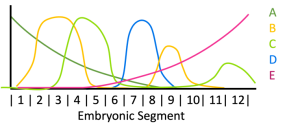Wrap Up Questions
1. To observe a recessive maternal effect phenotype, the mother of an individual must be homozygous for the mutation. The individual’s genotype does not affect its phenotype. Many forward genetic screens began by treating flies with a mutagen and screening offspring of the flies for phenotypes. The offspring would typically inherit only one copy of any germline mutant alleles. Dominant germline maternal effect mutations would cause a phenotype change in the F1 generation, but recessive and maternal effect mutations would not.
- Describe a series of crosses that could generate offspring with a recessive mutant phenotype.
- Describe a series of crosses that could generate offspring affected by a maternal effect mutation.
2. Mitochondrial inheritance shows a pattern where all offspring have the same phenotype as their mother. How is that different from the expression patterns you would see for a maternal effect gene?
3. A gene is regulated by the enhancers listed in the table below. In which segments would the gene be expressed?
| Enhancer | Activators | Repressors |
| 1 | A+B | C |
| 2 | D+E | B+C |
 4. Compare and contrast eukaryotic and prokaryotic gene regulation. How are they similar? How are they different?
4. Compare and contrast eukaryotic and prokaryotic gene regulation. How are they similar? How are they different?
5. List four mechanisms by which genes can be regulated other than via transcriptional activators and repressors.
6. There are multiple ways to define a gene. Thinking about the characteristics that make up a gene, would you characterize the ZRS as a gene? Would you characterize the part of the genome that encodes an miRNA a gene? Explain your reasoning.
Science and Society
7. A discussion of the history behind some of the creative Drosophila names is found in this 2012 article from Harvard Magazine. Do you agree or disagree with the researchers quoted in the article? What are the benefits and disadvantages of such a system? Should insensitively-named genes be renamed?
Media Attributions
- Wrap Up Question Regulation by Enhancers © Amanda Simons is licensed under a CC BY (Attribution) license

